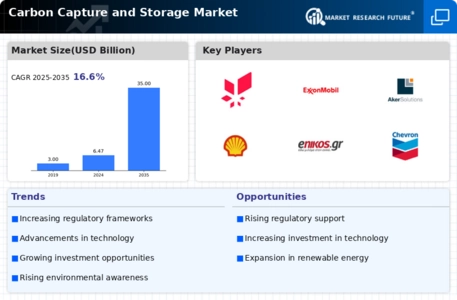Technological Innovations
Technological innovations play a pivotal role in shaping the Carbon Capture and Storage Market. Advancements in capture technologies, such as direct air capture and bioenergy with carbon capture and storage, are enhancing the efficiency and cost-effectiveness of carbon capture processes. Recent developments indicate that new materials and methods are being explored to improve capture rates and reduce energy consumption. For example, the introduction of advanced sorbents and membranes has the potential to lower operational costs significantly. As these technologies mature, they are expected to attract substantial investments, with projections suggesting that the market could reach a valuation of several billion dollars by the end of the decade. The continuous evolution of technology is likely to drive the Carbon Capture and Storage Market forward, making it a critical component of global climate strategies.
Public Awareness and Support
Public awareness regarding climate change and the importance of carbon management is on the rise, positively influencing the Carbon Capture and Storage Market. As communities become more informed about the impacts of carbon emissions, there is a growing demand for effective solutions to mitigate these effects. This heightened awareness is leading to increased public support for carbon capture initiatives, which, in turn, encourages governments and industries to invest in these technologies. Surveys indicate that a significant portion of the population supports the implementation of carbon capture projects, viewing them as essential for achieving climate goals. This societal shift towards sustainability is likely to bolster the Carbon Capture and Storage Market, as stakeholders recognize the necessity of integrating carbon capture solutions into broader environmental strategies.
Corporate Sustainability Initiatives
In the Carbon Capture and Storage Market, corporate sustainability initiatives are becoming increasingly prevalent. Many companies are recognizing the importance of reducing their carbon footprints and are investing in carbon capture technologies as part of their sustainability strategies. This trend is particularly evident in sectors such as energy, manufacturing, and transportation, where emissions are substantial. A report indicates that over 70 percent of Fortune 500 companies have set net-zero emissions targets, which necessitates the integration of carbon capture solutions. As businesses strive to enhance their environmental credentials, the demand for carbon capture technologies is expected to rise, further propelling the growth of the Carbon Capture and Storage Market. This alignment of corporate goals with environmental responsibility is likely to create a robust market for innovative carbon management solutions.
Increasing Environmental Regulations
The Carbon Capture and Storage Market is experiencing a surge in demand due to the tightening of environmental regulations across various regions. Governments are implementing stricter emissions targets, compelling industries to adopt carbon capture technologies. For instance, the European Union has set ambitious climate goals, aiming for a 55 percent reduction in greenhouse gas emissions by 2030. This regulatory landscape creates a favorable environment for the Carbon Capture and Storage Market, as companies seek compliance and sustainability. The market is projected to grow significantly, with estimates suggesting a compound annual growth rate of over 20 percent in the coming years. As regulations become more stringent, the necessity for effective carbon management solutions will likely drive investments in carbon capture technologies.
Investment in Research and Development
Investment in research and development is a crucial driver for the Carbon Capture and Storage Market. Governments and private entities are allocating substantial funds to advance carbon capture technologies, recognizing their potential to combat climate change. Recent funding initiatives have highlighted the importance of innovation in enhancing the efficiency and scalability of carbon capture solutions. For instance, various countries have established grants and incentives to support R&D efforts in this field. This financial backing is expected to accelerate the development of new technologies and methodologies, ultimately leading to more effective carbon capture systems. As R&D continues to flourish, the Carbon Capture and Storage Market is likely to benefit from a pipeline of innovative solutions that can address the pressing challenges of carbon emissions.

















Leave a Comment